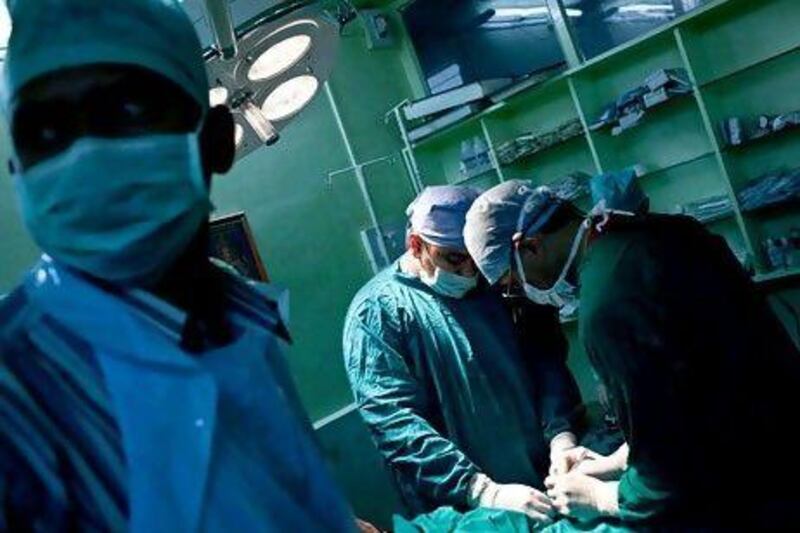Anyone reading the business pages recently could not fail to notice that international private-equity companies see India as their favourite destination.
And there is one sector that stands out: medical services.
The headlines prove it: Jardine Rothschild Asia Capital to make $40 million investment in Quality Care; or General Atlantic in talks over a $100m deal to buy DM Healthcare; or Aureos Capital invests $10m in BSR Super Speciality Hospitals.
Such investments came into vogue last year, and this year is shaping up to produce an equal number of deals, if not more.
Venture Intelligence, based in Mumbai, recently published a study detailing private-equity deal flows and predicted trends for this year.
"Our survey found that health care is the sector that investors expect to prefer the most in 2012. We expect the strong pace of investments in this sector to continue," said Arun Natarjan, the chief executive of Venture Intelligence.
Nervousness in the global market is driving investors away from initial public offerings (IPOs) and towards buyouts instead, he adds.
"The same survey also indicated an uptick in overall investment activity during 2012 - encouraged by the attractive valuations to be had in the current scenario, with public markets being shaky and not welcoming to new IPOs," Mr Natarjan says.
Already for this year, there is estimated to be more than US$2 billion (Dh7.34bn) in private-equity funds earmarked for the healthcare sector, the research noted.
Secondary buyouts will dominate this year, said N Muthuraman, the director of RiverBridge Investment Advisors.
"In the short term, secondary buyouts are more likely to happen as many funds may reach maturity this year without any other exit in sight. This could have a sobering effect on the valuations, as secondary transactions are typically done at lower multiples than IPOs," he said.
The headlines are hardly surprising if you consider the sector's potential. The value of India's healthcare industry was pegged at close to $50bn in 2010 and has been growing at an average annual rate of 17 per cent over the past five years, according to India Brand Equity Foundation.
India needs everything from ambulances to clinical equipment, hospitals to vaccines. The public sector is suffering enormously from crowding, low public spending and poor infrastructure.
"India's expenditure on health care is much below global averages," said Gawir Baig, associate vice president of O3 Capital, an investment banking company.
"India's share in the global disease burden is 20 per cent, but its share of healthcare infrastructure is much lower, with only 6 per cent share of global hospital beds and 8 per cent share of doctors and nursing staff. Public expenditure on healthcare in India is also unusually low."
The government cannot cope with the increasing burden, which means most of the gap will be filled by the private sector. But there are other growth drivers, too.
"India is a very nascent market. There are supply-side constraints, which adds to the growth potential," says Mr Baig. "In addition, there are macroeconomic factors, which provide an additional boost to the Indian healthcare space, such as rising income levels, increase in life expectancy and incidence of lifestyle disease."
Basic care - or primary health care - is the area to watch, as 80 per cent of all health requirements fall in this category. This category accounts for 60 per cent of the healthcare market and is growing at an average annual rate of 15 per cent. The market is worth $30bn but is likely to reach $200bn to $250bn by 2025, according to Technopak Advisors, a research house.
Primary care aside, there are opportunities in diagnostics, ambulance services and equipment maintenance, dental care, and daycare facilities, says KPMG, a global consultancy.
More than 80 per cent of India's health care is private, and companies have invested heavily in state-of-the-art equipment and methods to remain competitive. The cost of being treated in India is still very low, and as a result millions of foreigners go there for care.
Consequently, medical tourism is another driver of growth of the Indian healthcare sector. It is predicted to become a $100bn industry this year, according to a report by the research agency Frost & Sullivan.
It all sounds very positive. But, as with everything in India, there are snags. Any deal-making could be brought down by government red tape.
"There are still regulatory changes happening in certain sectors [such as pharmaceutical]," says Mahadevan Narayanamoni, a partner in corporate finance at Grant Thornton India, an audit, tax and advisory firm. "Regulatory uncertainties and delay in governmental decision-making are impacting the speed at which [venture capital and private equity] investments are happening."
A dearth of suitable targets is also a potential problem.
"One of the major challenges for private-equity investors in India has been the short supply of good deals. And that has really not changed," Mr Narayanamoni says.
"As new sectors have gained prominence such as e-commerce, education, clean-tech and health care, some traditional favourites are not that favoured any more such as infrastructure, retail and financial services," he says.
While the private-equity players may well be sharpening their teeth for their next bite, the IPO pipeline is expected to remain dry.
"We don't see any of the mid-size players doing an IPO, given the sentiments on the IPO markets for 2012, and none of the mid-sized healthcare companies have crossed the $100m to $125m threshold turnover to make it an ideal candidate for a public issue," says Mr Baig.





